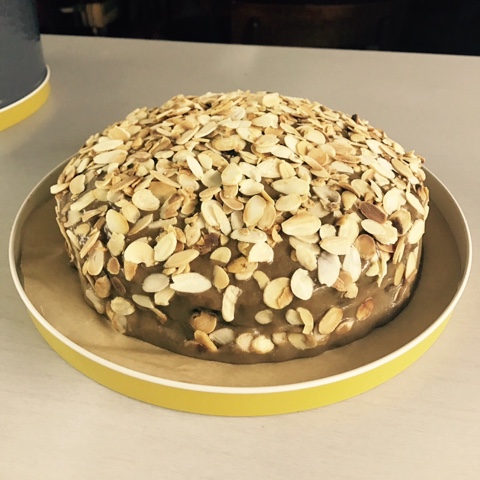Aside from the decoration, the cake itself, a genoese sponge, was a new challenge for me, although it makes regular appearances on the Great British Bake Off. The ingredients don't include any raising agents, such as baking powder or self raising flour, so you need to incorporate plenty of air as you whip together the eggs and sugar, then make sure to keep the air as you fold in the butter and flour. This should result in a light but firm sponge, and is used as the basis for many patisserie creations. I can't find any reason why this method is better than using chemical raising agents, so maybe it's just a fun way to stress out home bakers.
Ingredients
For the Genoese sponge:
250g caster sugar
8 eggs
250g plain flour
100g unsalted butter
A shot of kalua and a shot of amaretto (optional, and unpictured as decided to add halfway through...)
For the coffee cream icing:
1/2 pint milk
3 drops vanilla extract
130g caster sugar
4 egg yolks
150g unsalted butter
2 tbsp instant coffee
3 handfuls flaked almonds
Method
Make the sponge a day or two before decorating (and eating) the cake.
1. Beat together the sugar and eggs vigorously (with an electric mixer if you have one) over a pan of water, heating gently. Keep mixing until it has doubled in volume and the whisk leaves ribbons in the mix - it will take a good few minutes.
2. Take off the heat and whisk in the liqueur if using. Fold in the flour using a figure of eight movement to avoid knocking out the air. Warm the butter and dribble down the side of the bowl and fold in gently.
3. Lightly grease and line a deep 20cm cake tin with baking paper, and sprinkle with flour. Pour in the cake mixture.
4. Bake in a preheated oven at 180C for 50 minutes, or until the whole cake is golden brown. This leaves plenty of time to go to work on licking the bowl...
5. Leave to cool, remove from the tin and cool completely on a wire rack. Store in an airtight container until ready to decorate.
For the icing and decorating:
1. Make a crême anglaise by heating the milk gently to boiling point, adding the vanilla and taking off the heat. Beat the eggs and sugar together then add the cooled milk.
2. Return to the heat until the cream has thickened enough to coat the back if a spoon. Cool, then pour onto the butter in a bowl and combine, add the coffee and mix well.
3. Toast the flaked almonds in a dry frying pan, shaking regularly.
4. Cut the cake in half horizontally and spread some coffee cream over the bottom layer, smoothing with wet palette knife.
5. Add the top half of the cake and cover completely with the cream. When set, decorate with the toasted almonds and a sprinkling of icing sugar.
The final cake has a moist sponge with a hint of coffee and almond from the liqueurs, and a rich creamy coffee topping balanced with the crunchy almonds.
Serve with prosecco and complimentary friends for a very happy new year!















No comments:
Post a Comment